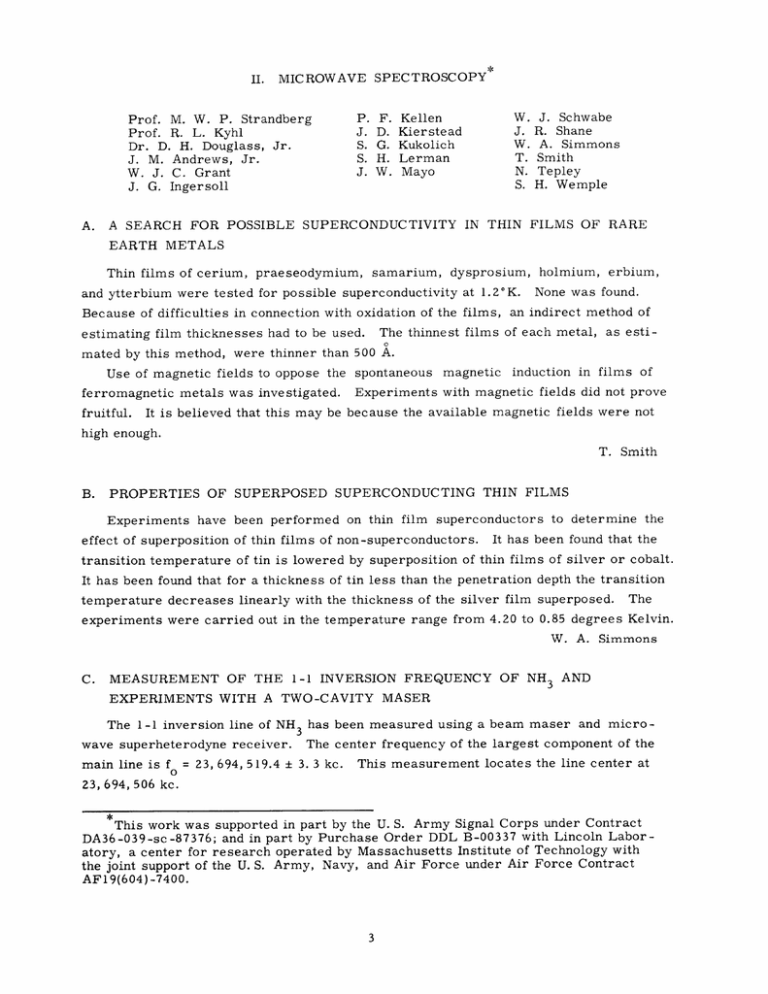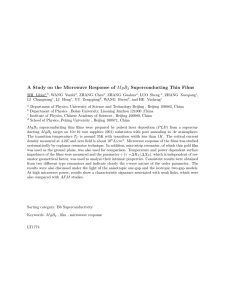W. J. Schwabe P. F. Kellen
advertisement

II. MICROWAVE Prof. M. W. P. Strandberg Prof. R. L. Kyhl Dr. D. H. Douglass, Jr. J. M. Andrews, Jr. W. J. C. Grant J. G. Ingersoll A. P. J. S. S. J. SPECTROSCOPY F. D. G. H. W. Kellen Kierstead Kukolich Lerman Mayo W. J. W. T. N. S. J. Schwabe R. Shane A. Simmons Smith Tepley H. Wemple A SEARCH FOR POSSIBLE SUPERCONDUCTIVITY IN THIN FILMS OF RARE EARTH METALS Thin films of cerium, praeseodymium, samarium, dysprosium, holmium, erbium, and ytterbium were tested for possible superconductivity at 1.2*K. None was found. Because of difficulties in connection with oxidation of the films, an indirect method of estimating film thicknesses had to be used. The thinnest films of each metal, as estimated by this method, were thinner than 500 A. Use of magnetic fields to oppose the spontaneous magnetic induction in films of ferromagnetic metals was investigated. Experiments with magnetic fields did not prove fruitful. It is believed that this may be because the available magnetic fields were not high enough. T. Smith B. PROPERTIES OF SUPERPOSED SUPERCONDUCTING THIN FILMS Experiments have been performed on thin film superconductors to determine the effect of superposition of thin films of non-superconductors. It has been found that the transition temperature of tin is lowered by superposition of thin films of silver or cobalt. It has been found that for a thickness of tin less than the penetration depth the transition temperature decreases linearly with the thickness of the silver film superposed. The experiments were carried out in the temperature range from 4.20 to 0.85 degrees Kelvin. W. A. Simmons C. MEASUREMENT OF THE 1-1 INVERSION FREQUENCY OF NH 3 AND EXPERIMENTS WITH A TWO-CAVITY MASER The 1-1 inversion line of NH 3 has been measured using a beam maser and microwave superheterodyne receiver. The center frequency of the largest component of the main line is f = 23, 694, 519.4 ± 3. 3 kc. This measurement locates the line center at 23, 694, 506 kc. This work was supported in part by the U. S. Army Signal Corps under Contract DA36-039-sc-87376; and in part by Purchase Order DDL B-00337 with Lincoln Laboratory, a center for research operated by Massachusetts Institute of Technology with the joint support of the U. S. Army, Navy, and Air Force under Air Force Contract AF19(604)-7400. (II. MICROWAVE SPECTROSCOPY) A very sensitive spectrometer has been constructed, using a two-cavity maser to produce a super-radiant state. The advantage of this scheme is that an optimum molec - ular signal can be obtained which is separate from the input signal. The geometrical representation of the Schridinger equation developed by Feynman is used to analyze the one- and two-cavity masers. The inversion spectrum and some characteristics of the inversion obtained by using a parabolic potential with Gaussian perturbation are discussed in the author's Bachelor's thesis submitted to the Department of Physics, M. I. T., May 1962. S. D. G. Kukolich EXPERIMENTS WITH MICROWAVE PHONONS A system for the generation of monochromatic longitudinal phonons of X-band frequency has been perfected and measurements of acoustic attenuation in metals can be started. The system consists of an X-cut quartz transducer, in a re-entrant cavity, excited by means of the piezoelectric effect with a pulsed magnetron. The hypersound is detected as microwave power generated by the inverse piezoelectric effect with a superheterodyne receiver. The generator has been successfully operated at frequencies from 8. 64 kmc to 9. 24 kmc by changing slightly the position of the quartz in the cavity. As many as 225 acoustic echoes have been observed with a decay time of 7. 5 x 10-5 -5 3 X 105 second. It has been found that the generator operates most efficiently at higher frequencies, with the transducer positioned far from the re-entrant post. The significance of this finding is being investigated. BC-cut quartz transducers are now being made for the purpose of generating transverse phonons. A second re-entrant cavity and receiver system will be constructed to make transmission, as well as reflection, experiments possible. Then metal crystals of various orientations will be sandwiched between two transducers, and the sound propagation through the crystal, as a function of magnetic field, will be studied. This study will give information about the Fermi surface of the metal or properties of superconductors. Such experiments are difficult with the single-cavity reflection technique because of the large acoustic losses across the quartz metal bond; echoes reaching the receiver from the metal are several orders of magnitude weaker than those coming from the bond, so that a receiver with sufficient gain to detect the former will be saturated by the latter. N. Tepley







